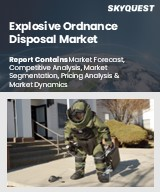
세계의 폭발물 처리 시장 규모는 2023년에 81억 달러로 평가되며, 2024년 86억 6,000만 달러에서 2032년에는 147억 7,000만 달러로 성장하며, 예측 기간(2025-2032년)의 CAGR은 6.9%로 성장할 전망입니다.
세계 폭발물 처리(EOD) 시장은 진화하는 국방 전략, 정부 투자 강화, 급속한 기술 발전에 힘입어 강력한 성장세를 보이고 있습니다. 각국 정부는 최첨단 EOD 기술을 채택하여 국토 안보 및 대테러 역량을 강화하는 한편, AI와 머신러닝의 혁신으로 위협 식별을 강화하고, 로봇이 위험한 환경을 효율적으로 이동하고 실시간 통신을 할 수 있도록 하는 등 국방 인프라의 현대화를 우선순위에 두고 있습니다. 이 산업은 괄목할 만한 기술 진화를 이루고 있습니다. 이러한 진화를 통해 폐기물 처리의 속도와 정확성도 향상되고 있습니다. 또한 5G 지원 명령 시스템의 통합으로 응답 시간이 더욱 단축되고 원격 조작의 정확도가 향상되어 폭발물 처리의 미래에서 첨단 기술의 역할이 확고히 자리 잡고 있습니다.
Global Explosive Ordnance Disposal Market size was valued at USD 8.1 billion in 2023 and is poised to grow from USD 8.66 billion in 2024 to USD 14.77 billion by 2032, growing at a CAGR of 6.9% during the forecast period (2025-2032).
The global explosive ordnance disposal (EOD) market is experiencing robust growth fueled by evolving defense strategies, enhanced government investments, and rapid technological advancements. Governments worldwide prioritize modernizing defense infrastructure while bolstering homeland security and counterterrorism capabilities by adopting cutting-edge EOD technologies. The industry has undergone significant technological evolution, with innovations in AI and machine learning enhancing threat identification and enabling robots to efficiently navigate hazardous environments and conduct real-time communication. This evolution has also improved the speed and precision of waste disposal. Additionally, the integration of 5G-enabled command systems has further accelerated response times and augmented the accuracy of remote operations, solidifying the role of advanced technology in the future of explosive ordnance disposal.
Top-down and bottom-up approaches were used to estimate and validate the size of the Global Explosive Ordnance Disposal market and to estimate the size of various other dependent submarkets. The research methodology used to estimate the market size includes the following details: The key players in the market were identified through secondary research, and their market shares in the respective regions were determined through primary and secondary research. This entire procedure includes the study of the annual and financial reports of the top market players and extensive interviews for key insights from industry leaders such as CEOs, VPs, directors, and marketing executives. All percentage shares split, and breakdowns were determined using secondary sources and verified through Primary sources. All possible parameters that affect the markets covered in this research study have been accounted for, viewed in extensive detail, verified through primary research, and analyzed to get the final quantitative and qualitative data.
Global Explosive Ordnance Disposal Market Segments Analysis
Global Explosive Ordnance Disposal Market is segmented by Type, Mobility, Operational Range, End Use and region. Based on Type, the market is segmented into Remote controlled and Autonomous/semi-autonomous. Based on Mobility, the market is segmented into Tracked robots, Wheeled robots, Legged robots and Hybrid. Based on Operational Range, the market is segmented into Short-range (500 meters), Medium-range (500m - 2 km) and Long-range (>2 km). Based on End Use, the market is segmented into Defense & military, Law enforcement, Homeland security and Others. Based on region, the market is segmented into North America, Europe, Asia Pacific, Latin America and Middle East & Africa.
Driver of the Global Explosive Ordnance Disposal Market
The global Explosive Ordnance Disposal (EOD) market is experiencing significant growth, primarily driven by increased investments in defense modernization by leading economies such as China, India, and the United States. These nations are prioritizing the development and procurement of sophisticated EOD equipment, including advanced bomb suits, artificial intelligence-enabled detection systems, and autonomous robotic solutions for military and homeland security applications. This surge in demand reflects the ongoing commitment to bolster national security and enhance operational capabilities. Consequently, technologically advanced nations and defense contractors are capitalizing on this trend, establishing themselves as key players in the evolving EOD landscape.
Restraints in the Global Explosive Ordnance Disposal Market
The global market for explosive ordnance disposal (EOD) faces considerable restraint due to the substantial investments required in research, development, and training for advanced EOD systems, which include AI-driven robots, bomb suits, and detection drones. These financial demands create barriers to widespread adoption, particularly impacting developing nations that struggle with limited defense budgets. The high costs associated with procurement and maintenance further hinder the penetration of EOD technologies in regions that cannot accommodate such expenditures, thereby constraining the growth potential of the market as a whole and emphasizing the need for cost-effective solutions to enhance accessibility and implementation.
Market Trends of the Global Explosive Ordnance Disposal Market
The Global Explosive Ordnance Disposal (EOD) market is witnessing a significant trend towards the integration of artificial intelligence (AI) and self-sufficient technologies in EOD robots. This advancement enhances operational safety and efficiency in complex bomb disposal missions, allowing for improved threat detection and real-time decision-making. Nations such as the U.S., UK, and South Korea are at the forefront of this shift, developing semi-autonomous robots adept at navigating GPS-denied and high-risk environments. As the demand for sophisticated solutions in explosive threat management rises, this trend is expected to drive growth and innovation within the EOD market, reshaping the landscape of defense and public safety.